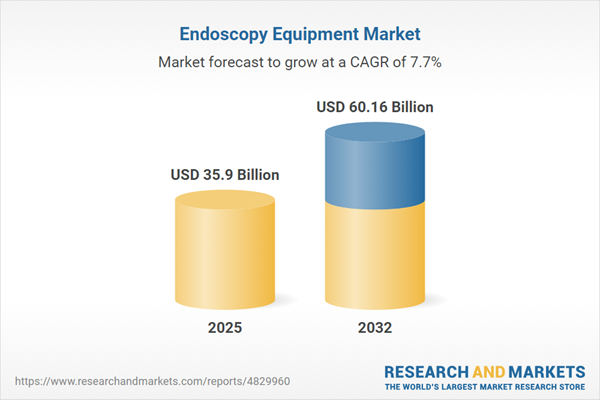Speak directly to the analyst to clarify any post sales queries you may have.
The endoscopy equipment market is evolving rapidly as decision-makers respond to changing clinical demands and regulatory priorities. Healthcare leaders are balancing innovation, operational resilience, and compliance to navigate a dynamic environment and drive lasting value across their organizations.
Market Snapshot: Endoscopy Equipment Market Size and Growth
In 2024, the global endoscopy equipment market reached USD 33.29 billion, with projected growth to USD 60.16 billion by 2032 at a compound annual growth rate of 7.67%. Expansion is propelled by rising demand for minimally invasive procedures and ongoing progress in digital imaging technologies. Organizations are adapting by emphasizing platform integration, workflow optimization, and scalable, interoperable solutions, while advances in technology and shifts in regional adoption are shaping competitive dynamics throughout the sector.
Scope & Segmentation of the Endoscopy Equipment Market
- Device Types: Capsule endoscopes, bronchoscopes, colonoscopes, gastroscopes, duodenoscopes, arthroscopes, laparoscopes, and devices tailored for gynecology and urology provide precise and efficient tools for specific diagnostic and therapeutic objectives in surgical and outpatient settings.
- Applications: Diagnostic and therapeutic endoscopy is deployed across ear, nose, and throat, gastroenterology, urology, gynecology, and general surgery procedures, enabling interdisciplinary teams to offer comprehensive and continuous care for a range of patient needs.
- Modalities: Enhanced digital imaging, improved connectivity, and diverse procedural options support quick clinical decision-making and drive broader access to advanced endoscopic care.
- End Users: Hospitals, specialty clinics, and ambulatory surgical centers utilize advanced solutions to meet increasing caseloads, enhance infection prevention protocols, and align with current compliance standards.
- Product Types: A combination of single-use and reusable endoscopes allows providers to balance infection control, cost management, and environmental goals, with decision-making influenced at both the administrative and clinical levels.
- Geographies: Adoption trends vary by region, influenced by regulatory frameworks and healthcare infrastructure maturity. North America, Germany, and Japan drive innovation, while expansion and market access in China and India redefine growth and competitive opportunity.
- Companies Analyzed: Olympus Corporation, Fujifilm Holdings, KARL STORZ, Richard Wolf, HOYA, Stryker, Boston Scientific, Medtronic, CONMED, and Smith & Nephew deliver tailored solutions globally, supporting a range of strategic healthcare objectives.
Key Takeaways for Senior Decision-Makers
- Digital imaging advances, robotics, and artificial intelligence are redefining infrastructure, supporting strategic planning and targeted investment in next-generation endoscopy systems.
- Effective infection prevention underpins procurement and supply strategies, making supplier agility and inventory continuity essential for safe, uninterrupted patient care.
- State-of-the-art systems streamline workflows and help healthcare networks scale operational capabilities, enhancing service delivery across multiple sites.
- Changing compliance standards require adaptable risk management, ensuring business continuity for organizations operating across diverse geographies.
- Collaboration with digital technology partners accelerates implementation of robotic and modular platforms, improving efficiency and care quality organization-wide.
Tariff Impact: United States Tariff Adjustments
Upcoming U.S. tariff changes for 2025 prompt procurement and supply chain leaders to reevaluate sourcing and production strategies. Emphasizing domestic manufacturing and responsive logistics can offset price fluctuations and help ensure steady device availability during regulatory transitions.
Methodology & Data Sources
This assessment draws on direct interviews with senior procurement and clinical stakeholders, reinforced by in-depth secondary analysis. All recommendations are validated by regulatory authorities, ensuring relevance and actionable guidance for the endoscopy equipment market.
Why This Report Matters
- Comprehensive segmentation allows healthcare executives to align investments with core strategic goals, optimizing resource allocation and patient care outcomes.
- Focused insights into technology and regulation help organizations proactively address supply chain challenges and emerging compliance risks.
- Benchmarking provides comparative perspective, supporting confident, data-driven decisions in complex healthcare technology environments.
Conclusion
Adoption of innovative technologies and rigorous compliance practices is strengthening endoscopic care capabilities, building organizational resilience and supporting sustainable performance across healthcare systems.
Additional Product Information:
- Purchase of this report includes 1 year online access with quarterly updates.
- This report can be updated on request. Please contact our Customer Experience team using the Ask a Question widget on our website.
Table of Contents
3. Executive Summary
4. Market Overview
7. Cumulative Impact of Artificial Intelligence 2025
Companies Mentioned
The companies profiled in this Endoscopy Equipment market report include:- Olympus Corporation
- Fujifilm Holdings Corporation
- KARL STORZ SE & Co. KG
- Richard Wolf GmbH
- HOYA Corporation
- Stryker Corporation
- Boston Scientific Corporation
- Medtronic plc
- CONMED Corporation
- Smith & Nephew plc
Table Information
| Report Attribute | Details |
|---|---|
| No. of Pages | 193 |
| Published | October 2025 |
| Forecast Period | 2025 - 2032 |
| Estimated Market Value ( USD | $ 35.9 Billion |
| Forecasted Market Value ( USD | $ 60.16 Billion |
| Compound Annual Growth Rate | 7.6% |
| Regions Covered | Global |
| No. of Companies Mentioned | 11 |









